Seven Questions Over Breakfast with John Rocco
 May 31st, 2011 by jules
May 31st, 2011 by jules
(Click to enlarge)
 That’s a spread from one of my favorite 2011 picture books, Blackout (Disney-Hyperion, May 2011), and it was written and illustrated by John Rocco, pictured here, who joins me for breakfast this morning. Have you seen this book, which has been met with such praise as “sublime” and “beautifully designed”? If not, I highly recommend you find the nearest copy on your library or bookstore shelf. It’s delightful. And if I were Publishers Weekly, I might say Rocco gets everything right in this book. So, I’m not PW, but they did say that about this book, and I nodded when I read that. Because it’s true.
That’s a spread from one of my favorite 2011 picture books, Blackout (Disney-Hyperion, May 2011), and it was written and illustrated by John Rocco, pictured here, who joins me for breakfast this morning. Have you seen this book, which has been met with such praise as “sublime” and “beautifully designed”? If not, I highly recommend you find the nearest copy on your library or bookstore shelf. It’s delightful. And if I were Publishers Weekly, I might say Rocco gets everything right in this book. So, I’m not PW, but they did say that about this book, and I nodded when I read that. Because it’s true.
Blackout tells the story of one busy family’s (and one community’s) magical, intimate evening together after the lights go out. Rocco, in the below video, calls the book his “ode to Brooklyn.” In fact, as Betsy Bird pointed out in this recent post (where you can see the excellent trailer for this book), New York City experienced its own 2003 blackout, upon which this book is based.
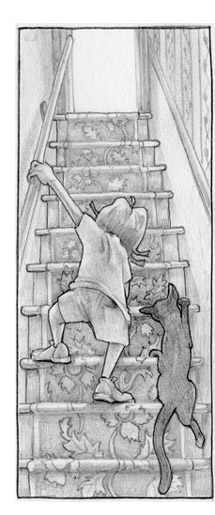 But one of the many ways in which this picture book works is that—as it probably goes without saying—this experience of a harried family, isolated by their own individual activities (dad is cooking, mom is online, and sis is on the phone) yet eventually brought together by the very absence of electricity, is mighty applicable in our 2011 hyper-hypo, cyber, always-online, always-connected, Facetwitter world. It’s downright moving and damn near tear-inducing, the moment when the family is sitting with candles and ice cream cones on the front steps: “And no one was busy at all.” In fact, when the lights come back on … well, I don’t want to ruin your experience of reading this book for yourself—the first time I read it was a lovely moment—but let’s just say the family has a very funny solution to the electricity’s return. It’s a refreshingly uncreative, yet clever, solution. (“Not all young readers will have experienced a blackout,” wrote the Kirkus review, “but this engaging snapshot could easily have them wishing for one.”)
But one of the many ways in which this picture book works is that—as it probably goes without saying—this experience of a harried family, isolated by their own individual activities (dad is cooking, mom is online, and sis is on the phone) yet eventually brought together by the very absence of electricity, is mighty applicable in our 2011 hyper-hypo, cyber, always-online, always-connected, Facetwitter world. It’s downright moving and damn near tear-inducing, the moment when the family is sitting with candles and ice cream cones on the front steps: “And no one was busy at all.” In fact, when the lights come back on … well, I don’t want to ruin your experience of reading this book for yourself—the first time I read it was a lovely moment—but let’s just say the family has a very funny solution to the electricity’s return. It’s a refreshingly uncreative, yet clever, solution. (“Not all young readers will have experienced a blackout,” wrote the Kirkus review, “but this engaging snapshot could easily have them wishing for one.”)
John’s here this morning to share some spreads from the book, as well as early sketches, etc. (Pictured right is a cutting from an early sketch.) He’s also generously sharing art from many of his other titles. (Way back in 2007, I covered his beautiful take on a classic Aesop tale.)
As John notes in this recent video interview from Brooklyn Public Library’s Drawn in Brooklyn (approximately seven minutes long and embedded here for those wanting to know more), prior to children’s book illustration he worked in the entertainment business as an Art Director. I think I speak for many when I say I’m glad he turned to children’s book illustration.
And I think he’s glad, too. Do a search in this interview for the phrase “lucky enough,” and you’ll see a man grateful for what he has in this life and thankful to be working in this business.
As for our cyber-breakfast feast this morning, John says, “Hmm … You know, when my five-year-old daughter wakes my wife and I up by running from her bedroom to ours (full sprint) at 6:00AM, leaps onto our bed and knees me in the groin (by accident), the last thing I want to do is jump out of bed and cook. So, yeah, cereal it is: low-fat, low-sugar, cartoon-less cereal with almond milk.”
However, John adds, “we are lucky enough to have a weekend house in the country and, when we are there, I LOVE to cook, especially when we have guests. I go all out, too: Blueberry pancakes, eggs, bacon, home fries — the full cardiac breakfast.”
Mmm. I think we’ll head over to their weekend house then for this Q&A, because that all sounds good to me.
I thank John for chatting with me this morning. I particularly enjoyed poring over all the art he sent.
Jules: Are you an illustrator or author/illustrator?
John: I still can’t believe that I have actually authored several books and someone would not be mistaken to introduce me as “the author, John Rocco.” I am an illustrator first and foremost. I became an author somewhat out of necessity. The second book I was contracted to illustrate was the Aesop fable, The Boy Who Cried Wolf, and to be completely honest I really didn’t like the kid in that story, so rather than say no to the possible book contract, I wrote my own version. Through that process, I discovered that I really enjoy writing.
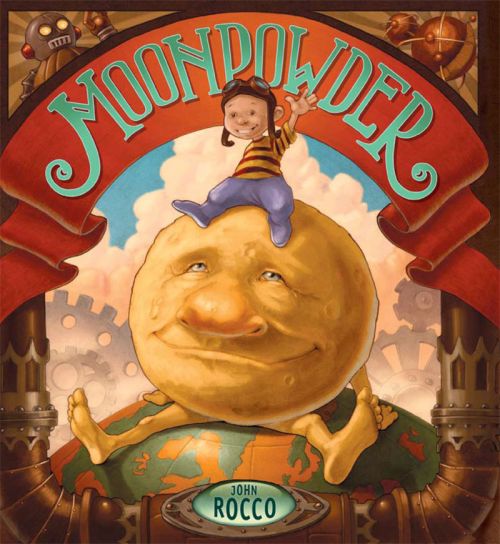
Jules: Can you list your books-to-date?
John:
- Alice by Whoopi Goldberg and illustrated by me; 1992, Bantam Doubleday Dell
- Wolf! Wolf!, written and illustrated by me; 2007, Disney-Hyperion
- Moonpowder, written and illustrated by me; 2008, Disney-Hyperion
- Fu Finds the Way, written and illustrated by me; 2009, Disney-Hyperion
- The Lightning Thief: Deluxe Illustrated Edition by Rick Riordan and illustrated by me; 2009, Disney-Hyperion
- Blackout, written and illustrated by me; 2011, Disney-Hyperion
- The Flint Heart by John and Katherine Paterson and illustrated by me; 2011, Candlewick
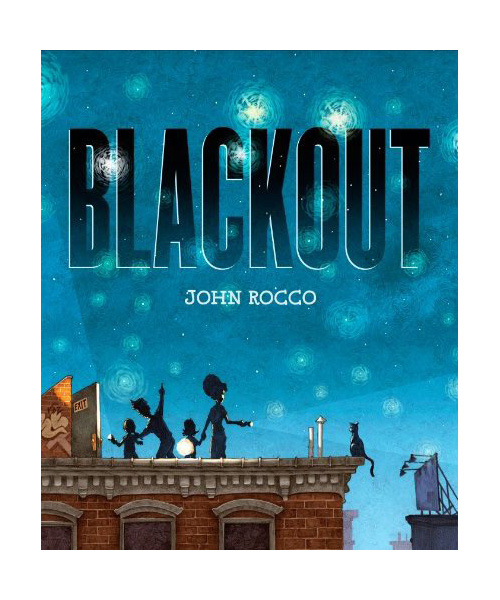
Jules: What is your usual medium, or––if you use a variety—your preferred one?
John: I like to use Berol Turquoise pencils on Strathmore Bristol paper (cold press) to do a tonal drawing, and then I scan it into my Mac and use Photoshop to apply the layers of color. Sometimes I will find or create textures to layer in as well. For example in my book Fu Finds the Way, I stained Bristol board with tea and then scanned it in (after it dried, of course!) and used those stains to give the images the aged look I was…er…looking for.
(Click to enlarge)
(Click to enlarge)
(Click each spread to enlarge)
Jules: If you have illustrated for various age ranges (such as, both picture books and early reader books OR, say, picture books and chapter books), can you briefly discuss the differences, if any, in illustrating for one age group to another?
John: The majority of the work I do is either picture book illustration or middle grade fantasy fiction. When I am illustrating a picture book, I usually end up spending a lot of time doodling the characters or particular scenes, and eventually my hand begins to tell me what kind of look the book is calling for. You can see those differences clearly when you look at the more cartoony illustrations for Blackout and the more rendered, realistic images in Fu Finds the Way. You will also notice that in Blackout the page is more of a stage, like in theatre, where the characters come and go and we are the stationary audience. In my other books, like Fu Finds the Way and Moonpowder, the images are more cinematic, with dramatic angles and a variety of views. I think these types of images are easier for older children to engage with.
from Moonpowder; click all but the third image to enlarge)
When I create artwork for middle grade fiction, I usually let the manuscript dictate the type of imagery. Usually after reading the manuscript, images start to float to the surface for me. Very rarely are those images scenes from the book, but rather something that represents the forces at work in the book. For instance, for my very first cover, Rick Riordan’s The Lightning Thief, I was intrigued by the boy who was somewhat “stuck” between the forces of Zeus and Poseidon. Since the boy, Percy, was the Son of Poseidon, I chose to illustrate him standing in the raging water with the thunderclouds of Zeus looming above him, both forces of nature pressing in on the lone boy. I think many kids that age probably feel like that. I know I did.
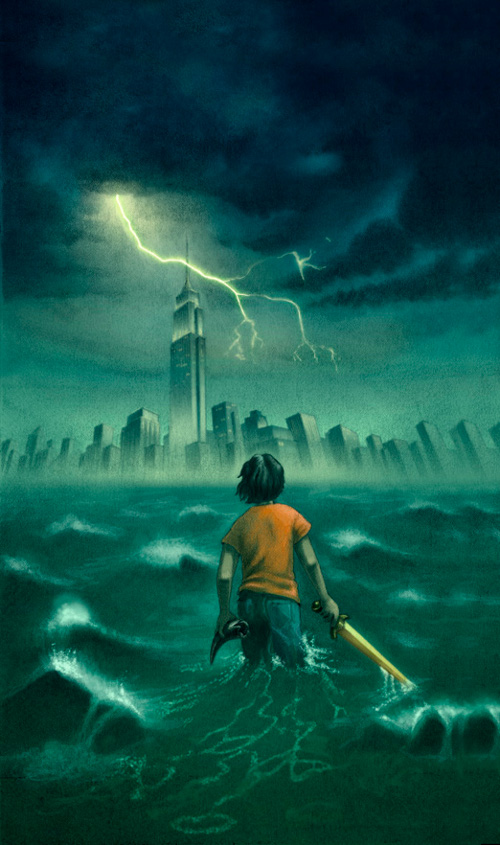
Jules: Where are your stompin’ grounds?
John: I wish I could say I was a stomper. That sounds cool. Or even a romper-stomper in steel-toed boots.
I live in a part of Brooklyn, New York, called Dumbo. It stands for Down Under the Manhattan Bridge Overpass. It is located exactly where it sounds. We live a spitball away from where the Manhattan Bridge lands in Brooklyn, and let me tell you…IT IS LOUD! When that train goes by, you feel it in your bones. We live in an old loft in a four-story brick building that was once a cardboard factory in the 1800s.
What I love about Brooklyn is the sheer number of book illustrators that live here. Over the last seven years, I have been lucky enough to meet and become good friends with many of them. My friend, Brian Floca, has a studio almost next door to mine. After this breakfast, I will probably go have lunch with him. (When will I get ANY work done with all of these meals to schedule?) On Fridays I usually get together with John Bemelmans Marciano so that our daughters can have a play date and we can scheme new ways to make better books. Just the other day my wife, Aileen Leijten, and I had fourteen illustrators over for a pot luck dinner and p.r. discussion. Sophie Blackall brings the wine, Sergio Ruzzier brings the cheese, and I provide the whiskey. Good times.
Jules: Can you briefly tell me about your road to publication?
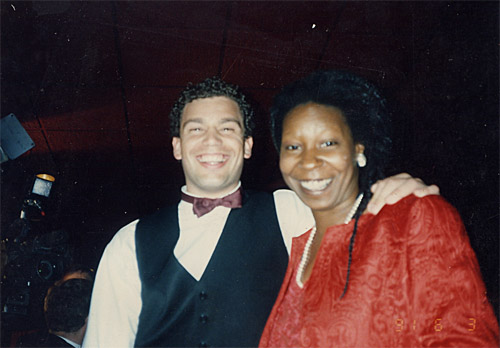
John: I have been lucky enough to have two shots at breaking into this business.
The first, which came exactly twenty years ago, happened was when I was in school at School of Visual Arts in NYC. I was working as a bartender in the theatre district, and one night the bar was hosting an after party for the Tony Awards. It was then that I met Whoopi Goldberg and handed her a promotional card. It was three 8 x 10 glossy photos of my illustrations mounted together as a triptych. On the front of this ensemble were some ransom note letters that read, “I have John Rocco’s portfolio and if you ever want to see it again call this number…” She was in this beautiful red sequin gown and here I am handing her this bulky letter sized cardboard mounted mailer. I assumed it was going to be dumped in the trashcan of the ladies’ room, but when I got home that night my roommate gave me a puzzled look and said “Whoopi Goldberg just called…” I called her back, obviously, and together we created the book, Alice. It was surreal.
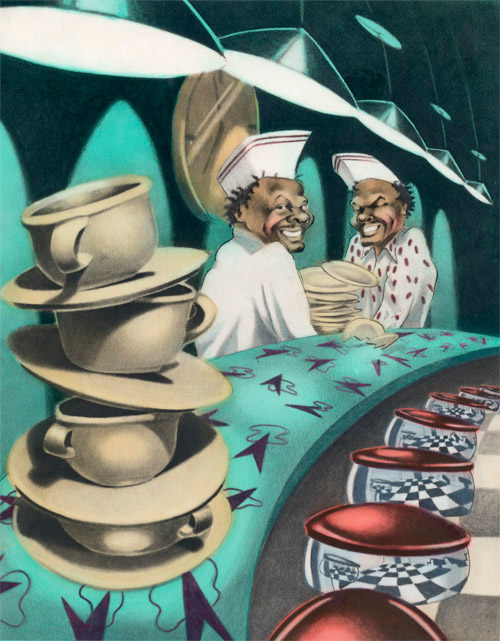

After that, I moved to Los Angeles with a portfolio of artwork and spent the next fifteen years working as an art director on everything from video games to films to theme parks.
The second time I broke into publishing came in the year 2005 after my wife and I had moved back to New York City. We had joined the Society of Children’s Book Writers and Illustrators, and my work had been discovered by some publishers at the annual SCBWI conference.
Jules: Can you please point readers to your web site and/or blog?
John: I am at www.roccoart.com. Blog: www.roccoart.blogspot.com. Me and some of my friends: www.bookmakersdozen.blogspot.com. I am also on Facebook.
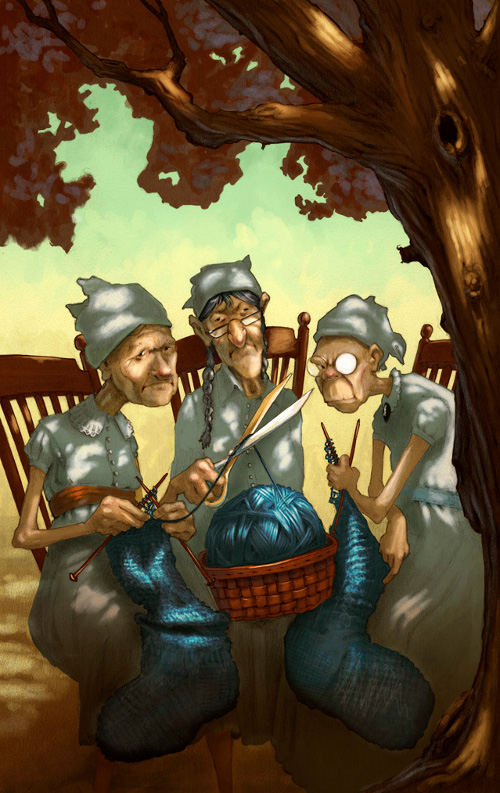
Jules: I see you do school visits. Tell me what they’re like.
John: I really enjoy school visits, because those kids can really keep you on your toes! The questions they ask usually range from “Do you really know Rick Riordan?” to “Do you wanna see my scab?”
My talks usually consist of a brief background: where I grew up, what my parents are like, and how discovered I liked drawing. Then I discuss all the different jobs I had before I started making books full-time. It is usually then that they discover I was an art director on Shrek and I designed theme park rides for Disney. (That’s when I have ’em hooked!)
(Click to enlarge)
The main ideas I try to get across in my talk is that my work doesn’t start off looking anything like the finished product. In fact, the drawings are downright horrible at first. So is the writing. But … if I keep re-working it and do it again and again and again … eventually I am able to create something that I am pleased with.
I think too many children get frustrated if a drawing doesn’t come out the way they want it to on the first go, so they give up or they don’t draw at all. I try to show that, like them, I don’t get it right the first time either. I don’t get it right on the second time, or the third, or fourth. But each time I get a little closer and the more I do it, the better it gets.
Jules: Any new titles/projects you might be working on now that you can tell me about?
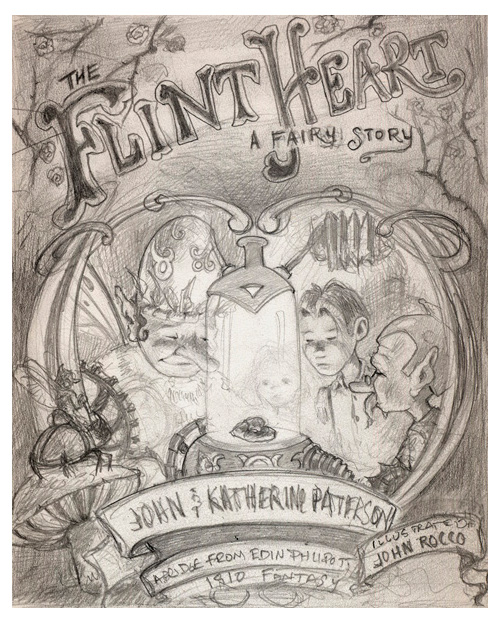
John: YES! Very excited about a new book I have coming out in the Fall. It is called The Flint Heart, written by John and Katherine Paterson and published by Candlewick. It is a middle grade novel that is based on Eden Philpotts’ 1910 fantasy. I created about sixty or so paintings for the book, and it will be printed in full-color. It has children, fairies, talking animals, and a hot water bottle from Germany named Bismark. What more does a story need?
I am also thrilled with the response to my brand new picture book, Blackout. It is the story of a Brooklyn family discovering the magic that can happen when the lights go out.
I have also illustrated a middle grade novel called Return to Exile by E.J. Patten. That will be coming out in the Fall as well. This book centers on the character, Sky Weathers, who joins up with a clan of teenagers who hunt monsters using technology fabricated from the junkyard. It is dark and cool and scary! I ended up doing about forty-four black and white illustrations for it.
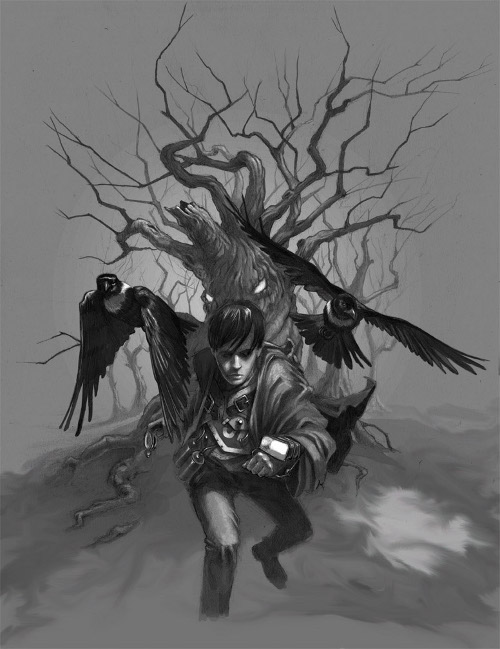
by E.J. Patten; Simon and Schuster, 2011
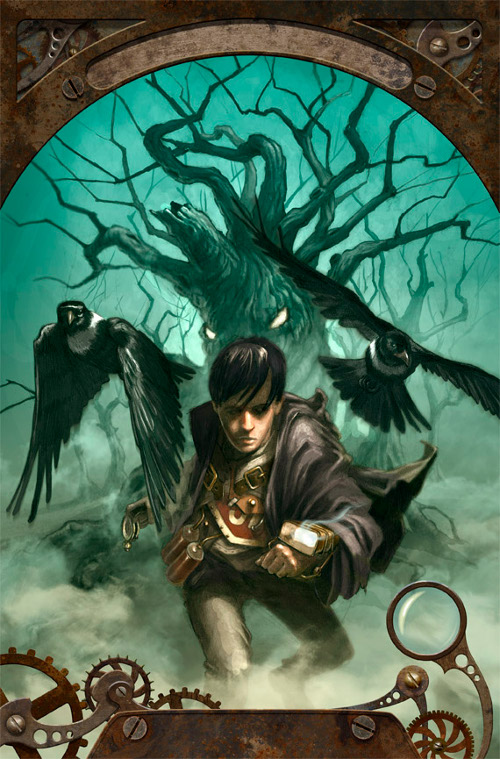

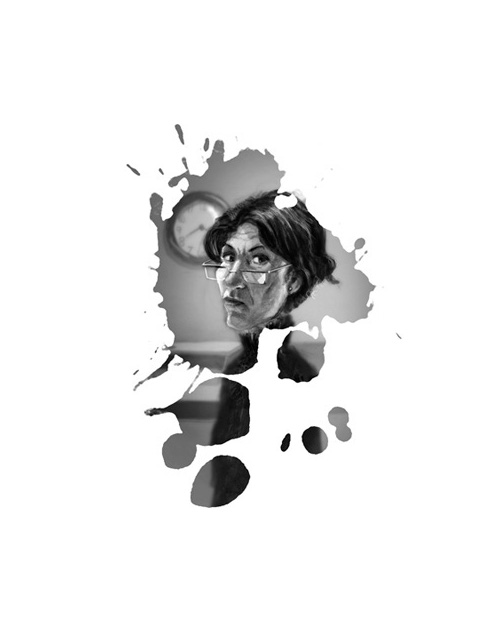
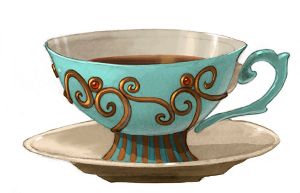 John didn’t necessarily specify tea for breakfast—and you can always find me brewing strong coffee—but we’re going to have some cyber-tea today, simply because I couldn’t pass up the opportunity to show one of John’s illustrated tea cups (a spot illustration from The Flint Heart). So, our tea is brewed and table’s set now for our breakfast interview. Let’s get a bit more detailed, and I thank John again for stopping by.
John didn’t necessarily specify tea for breakfast—and you can always find me brewing strong coffee—but we’re going to have some cyber-tea today, simply because I couldn’t pass up the opportunity to show one of John’s illustrated tea cups (a spot illustration from The Flint Heart). So, our tea is brewed and table’s set now for our breakfast interview. Let’s get a bit more detailed, and I thank John again for stopping by.
1. Jules: What exactly is your process when you are illustrating a book? You can start wherever you’d like when answering: getting initial ideas, starting to illustrate, or even what it’s like under deadline, etc. Do you outline a great deal of the book before you illustrate or just let your muse lead you on and see where you end up?
John: My process for creating books has a beginning, middle, and an end.
The beginning is the inspiration stage. That usually consists of filling one or two spiral bound sketchbooks with doodles and sketches. It is here where the real work is done. Most of the drawings are terrible, but the ideas start to take shape and, when I have filled enough pages and it is starting to come together, I will move on to stage two: the middle.
(Click to enlarge)
(Click to enlarge)
(Click to enlarge)
(Click to enlarge)
The middle is the book dummy stage. It is here where I try to take the ideas and put them together so they start to make sense, and I figure out how the book will flow. It usually starts out with a bunch of drawings blown up and taped to a wall so I can see them all at once. Luckily, I have two blank walls in my studio where I usually have taped up two different projects in various stages. Once I can see the entire book on the wall, I can start to re-arrange things, make notes, and tape new ideas right on top of them. Once that is working, I will then take the drawings and put them together into a book form so I can see the pages as they will appear in the final book. This is important so that I can see how one page flows into the other. The reader has to WANT to turn the page to see what happens next. This is usually where I find out if the book is really working or not.
(Click to enlarge)
The end stage is creating the final art. Once I have a working dummy, I will take each sketch and do a final piece of art for it. I don’t usually work from the beginning of the book to the end but rather jump around a bit. I’ll start off with a couple of paintings I am really excited about and ones that I know I can illustrate the heck out of. That way I can boost my confidence level for the ones that I am terrified to illustrate. (There are always a few of those.)

(Click to enlarge)
(Click to enlarge)
I do grade all of my sketches on level of difficulty (“1” being easy and “5” being hard), and I will do a few ones and twos to start, then tackle the fives while my energy and confidence are up, then I save a few more ones for the very end when I am tired and almost burned out. (Does that make sense? It does to me.)
2. Jules: Describe your studio or usual work space.
(Click to enlarge)
John: My studio space used to be in my loft. It was also my wife’s studio space and my daughter’s play space. About a year ago, I started renting a studio space in a building next door. I share it with a bunch of documentary filmmakers. I usually am surrounded by books and things taped to the wall, and I have two large monitors on my desk. When I need to draw, I push my keyboard out of the way, turn my desk lamp on, and get to work. When I paint, I switch out the drawing pad for a Wacom tablet and paint away. I have a dry erase board on the wall that I use as an oversized to do list, and then I also stick yellow post-its all over the sides of my monitor with important things like, grocery lists, latest book measurements, and deadline reminders.
(Click to enlarge)
(Click to enlarge)
3. Jules: As a book lover, it interests me: What books or authors and/or illustrators influenced you as an early reader?
John: When I was a kid, I had a copy of Roald Dahl’s James and the Giant Peach, illustrated by Nancy Ekholm Burkert. Her delicate pen and ink drawings fascinated me and scared me at the same time. It is a somewhat dark story, and her artwork was the perfect match.
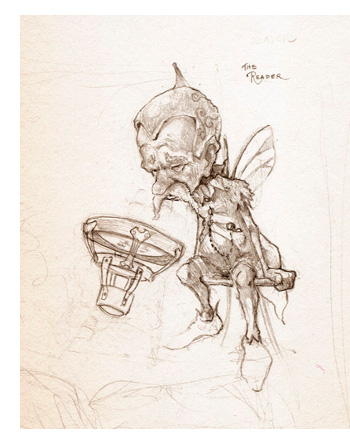 {Pictured right is a character study from John and Katherine Paterson’s The Flint Heart.}
{Pictured right is a character study from John and Katherine Paterson’s The Flint Heart.}
The other books that stood out for me were my dad’s collection of Classics Illustrated comics. They were my gateway to the Scribner editions of the same stories that were illustrated by N.C. Wyeth and Howard Pyle. Need I say more?
4. Jules: If you could have three (living) illustrators—whom you have not yet met—over for coffee or a glass of rich, red wine, whom would you choose?
John: I have been lucky enough to meet quite a few incredible illustrators in the last few years, some of whom I consider dear friends. If I were to pick three, okay, four that I would love to have over for some wine and conversation it would be the following:
Brian Selznick. (I am cheating here because we have met several times, but never really had time to talk or drink rich, red wine.) I love the way he thinks about books. How he sets the stage for his stories to unfold and how continues to break molds with the type of books he makes. I could learn a lot from him. Plus he is a very snappy dresser!
Shaun Tan. I have been in love with Shaun’s books for a long time, but when The Arrival came out I was blown away. Absolutely blown away. I ran around to everyone I knew and made him or her sit down and go through it page by page.
Tony DiTerlizzi. Big fan. Tony is massively talented and works very hard at his craft. NEWS FLASH: I recently reached out to Tony, because I am headed up to the Eric Carle Museum with my pals (John Marciano, Sophie Blackall, Brian Floca, and Sergio Ruzzier) and told him we would stop by his studio and bring him some coffee. Looks like it will happen in October, so I will keep you posted.
Rebecca Dautremer. My wife and I discovered her work on a trip to Belgium several years ago. Most of her books are published in French, but just recently her book The Lost Princesses was published here in America by Sterling under the title The Secret Lives of Princesses. Stunning work! Check it out.
{Ed. Note: Jules here. I have to quickly say that, yes, I’ve seen that book, pictured above left, and I give it seven very possible and enthusiastic thumbs-up. I’m glad you mention it, John, because I never got around to covering it here at 7-Imp last year, when it was released, but I very much enjoyed it. Now, back to our regularly scheduled programming….}
(Click to enlarge)
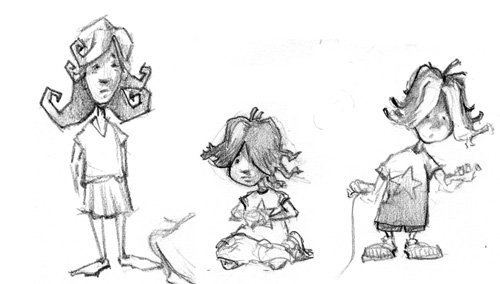
(Click to enlarge)
Final art for Blackout
(Click each spread to enlarge)
5. Jules: What is currently in rotation on your iPod or loaded in your CD player? Do you listen to music while you create books?
John: Actually, I don’t listen to music very often while I am working. What I like to do is have a film playing on my other monitor. I don’t watch it so much as I listen to it. It seems to keep part of my brain occupied so that I can focus the other part of my brain on the art. Old movies work really well for this, as they had great dialogue, because the writers came from radio (Casablanca, Maltese Falcon, Champion). I also watch…I mean listen to…documentary films. Most recently: Marwencol, When We Were Kings, and God Grew Tired of Us.
6. Jules: What’s one thing that most people don’t know about you?
John: The one thing most people don’t know about me is that I love to build things out of wood. I have been able to rekindle that passion recently, as we now have a wood shop in our country house, so when I go out there I love to build stuff. A couple years ago I made this dining room table that is now in our loft in Brooklyn.
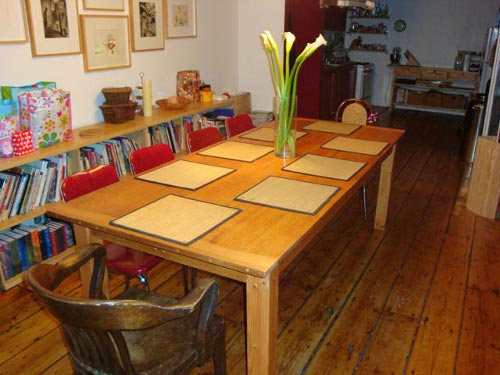
I also built some benches for my daughter’s kindergarten classroom. Those are very special, because they were made from the wood of a tree that was in my wife’s yard when she was a child. It’s a long story…
7. Jules: Is there something you wish interviewers would ask you — but never do? Feel free to ask and respond here.
John: “If you could illustrate a book by any living author who would it be?”
Kate DiCamillo. She is a wonderful storyteller and I am enamored by the worlds and characters she creates and would love nothing more than to spend a while living in one of her stories.
So, Kate, if you are reading this . . .

Jules: What is your favorite word?
John: “Awesome!”
Jules: What is your least favorite word?
John: “Impossible.”
Jules: What turns you on creatively, spiritually or emotionally?
John: Watching people achieve things they never thought they could do.
Jules: What turns you off?
John: Pessimism.
Jules: What is your favorite curse word? (optional)
John: I don’t have a favorite. I like them all equally.
Jules: What sound or noise do you love?
John: Rain on a tin roof.
Jules: What sound or noise do you hate?
John: A barista slamming the used grinds out of the espresso thingy. Can’t they find a better way to do that?
Jules: What profession other than your own would you like to attempt?
John: Mission control. I have always been fascinated by NASA.
Jules: What profession would you not like to do?
John: Airline attendant.
Jules: If Heaven exists, what would you like to hear God say when you arrive at the Pearly Gates?
John: “Good job. What would you like to be next?”
All artwork and images used with permission of John Rocco. All rights reserved.
THE FLINT HEART. Images copyright © 2011 by John Rocco. Reproduced by permission of the publisher, Candlewick Press, Somerville, MA.
BLACKOUT. Images copyright © 2011 by John Rocco. Published by Disney-Hyperion, New York.
The spiffy and slightly sinister gentleman introducing the Pivot Questionnaire is Alfred, © 2009 Matt Phelan. Thanks to Matt, Alfred now lives permanently at 7-Imp and is always waiting to throw the Pivot Questionnaire at folks.
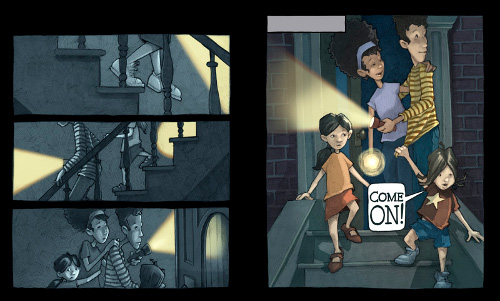
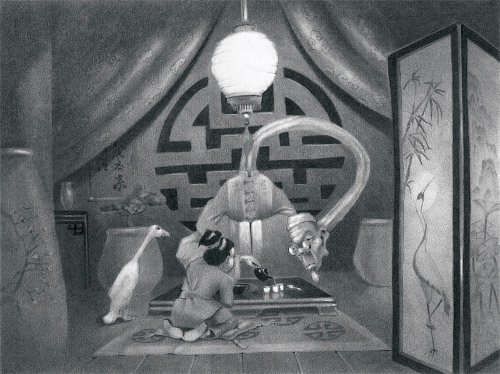

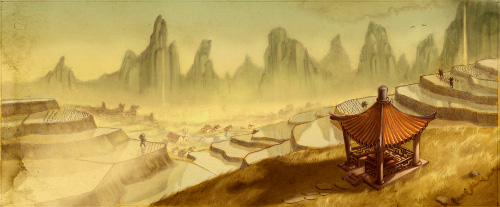

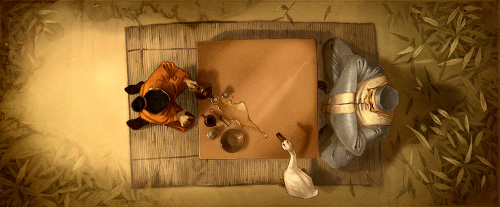

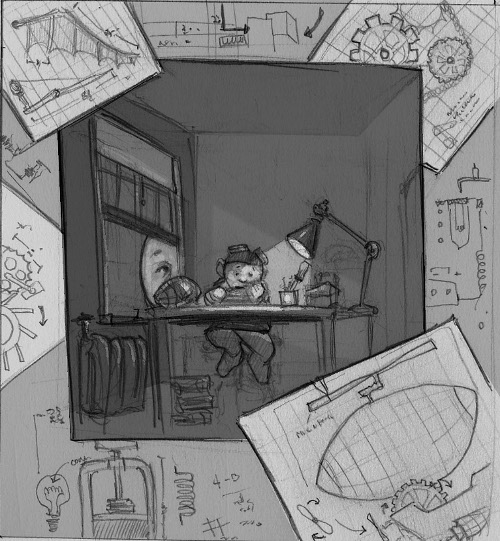
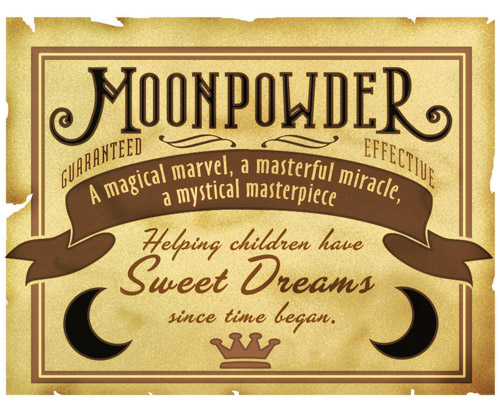
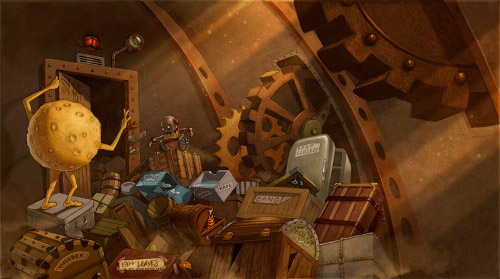
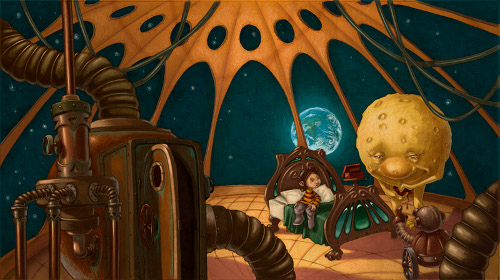
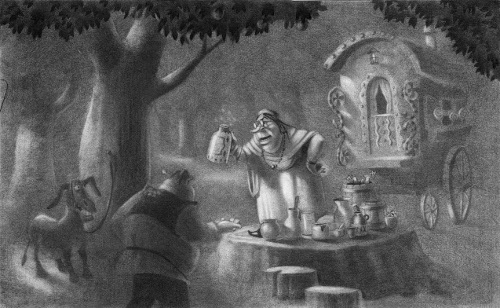

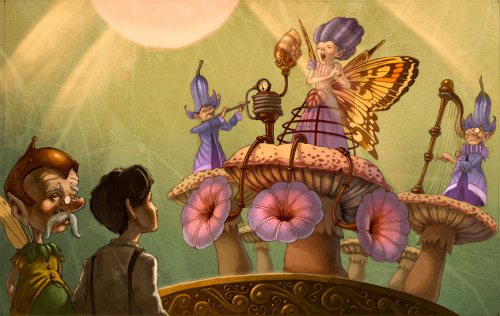
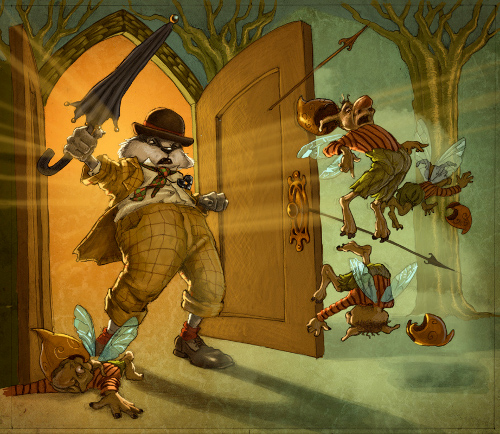

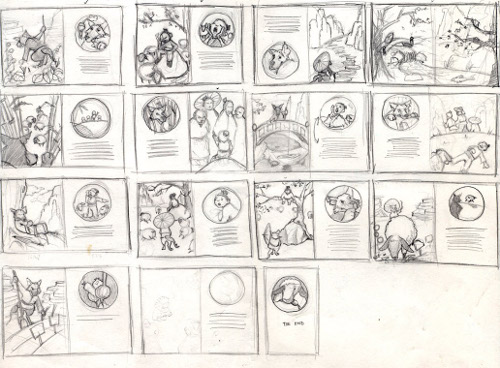
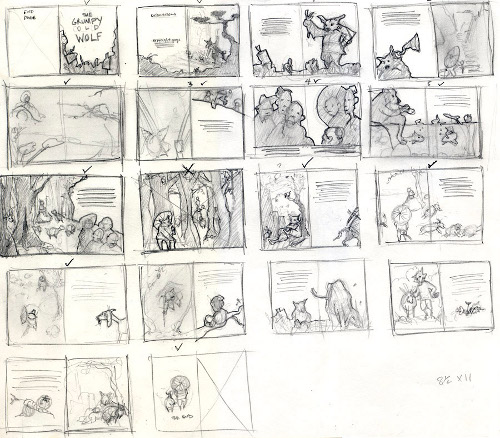

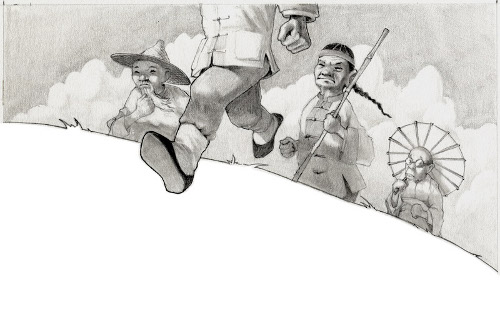
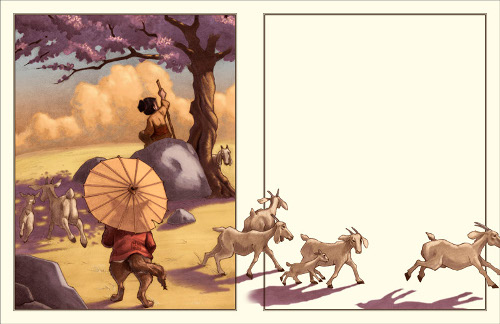
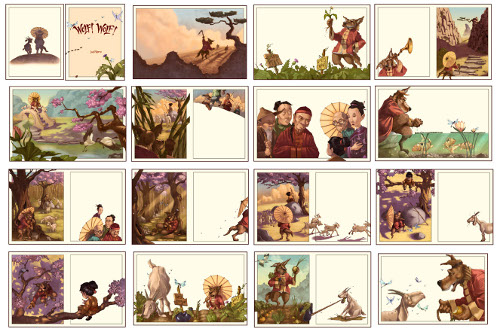
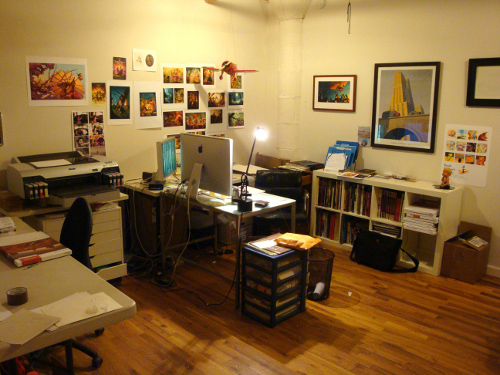
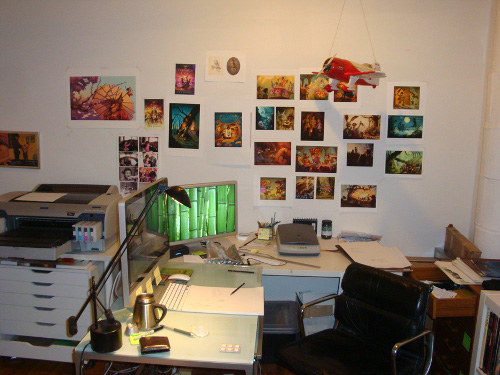
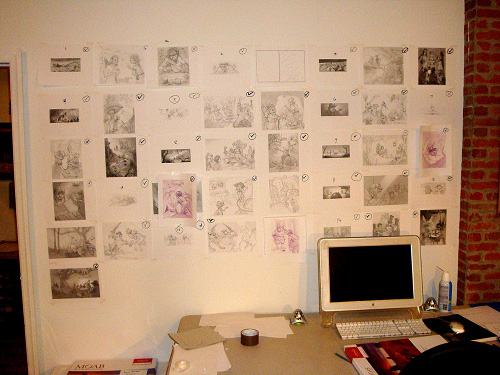

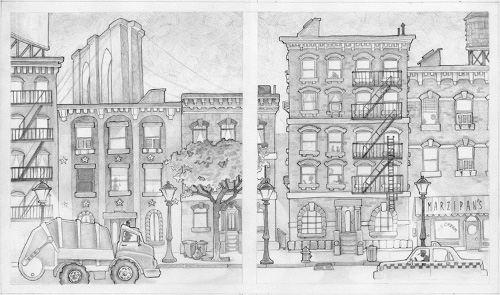
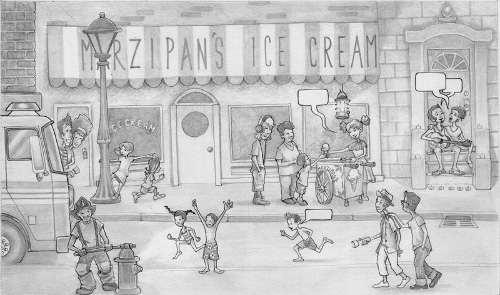


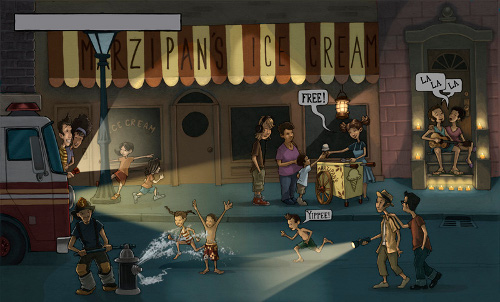

Enjoyed learning more about John. Did you notice that the moon’s face looks just like him? Such gorgeous, sumptuous work. Teacup made me very happy indeed; glad you decided to switch over from coffee just this once. And wouldn’t you like to be a fly on the wall at one of his illustrator potlucks?
I agree, Jama. What a gorgeously generous interview. Thank you both. I absolutely adore “Blackout.”
Wow, all kinds of awesome. So many delectable bits of art and as always, the stories behind them are fascinating…
I just really love the look of this “Blackout” book.
And, selfishly, I very much enjoyed hearing about his process. It strikes me as being about the smartest approach I’ve heard of. Love seeing the whole book at one time on the wall. ANd the numbering in order of difficulty/ fear of is SUCH a great idea.
I warn John Rocco that I am going to steal his process.
thanks John and Jules
amy june bates
Neat.
really enjoyed this interview. rocco does gorgeous work and it was great to learn more about him and his process.
That storyboard art would be fascinating to kids. It’s a real shame that with all the budget cuts now, students get less and less art, music, and lit.
Jules, you always blow me away with your thorough representation of an artist’s work. I just ran into John Rocco at BEA (see my blog for a description of said meeting) and he was charming. I don’t have the new book myself- yet – but looked through it and was very impressed by the style. It had me hankering for a little more about him, and here you are with art and answers. Thanks for that!
Lovely interview, thanks for posting! I always find it fascinating to see illustrators compare the picture books to movies or theatre. Will have to check out the book.
I met John and fell in love with his work within the instant. Especially BLACKOUT which is not only gorgeous but so smartly done. And after I drooled on it, he gave me a copy. GAVE it to me. (Must take this drooling trick to major conferences!)
Jane
[…] she left for the country (including an exciting loss of electricity in their home, making this one of two memorable picture book blackouts this year). She also fills her letter with the types of meandering details to which young children […]
[…] writing my own, creating dummies, and having professional portfolio critiques at conferences from John Rocco, Adam Rex, and Victoria Jamieson, I felt it was time to send one out. A Dog Is a Dog was the dummy […]
hey john my name is allison bell i also do art work and i was wondering if i can get a copy of the alice and whoopi goldberg that was one of my favorite books you wrote check out my art website at http://www.art-enables.org…..
[…] 7 Impossible Things Before Breakfast- I enjoyed reading this past article that was an interview with John Rocco. I actually read one of his books this week for my reading journal. It was called Blackout. It was one of his books that he actually illustrated and wrote. I loved the book because the illustrations were nothing like normal books, but more like comic books, which I think kids would be intrigued about. Below (in a different post) is a part of the book from the blog. I found it amazing that John Rocco is normally just an illustrator and that’s what he loves. He also has built rides for Disney and illustrated The Lightning Thief. I am very interested in seeing the illustrator’s POV on the words they create. […]
[…] Danielson, J. (2011). Seven questions over breakfast with john rocco. Retrieved from http://blaine.org/sevenimpossiblethings/?p=2143 […]
[…] author/illustrator John Rocco as a child. You can see that he and his barber weren’t super […]
[…] week, here at Kirkus, I chatted with author/illustrator John Rocco about his most recent picture book, Super Hair-o & the Barber of Doom (Disney/Hyperion, May […]
Would love you to visit our Prinary School in Huntington. You would be a wonderful inspiration for our students. Would you come to Long Island? What are your fees? Thank you for your beautiful work.
Lucy Marotta
[…] to speak at a session. I got there early yesterday to hear the keynote speaker, author-illustrator John Rocco. He’s pictured here, making a salient […]
[…] will tell you that she is quite magical.”(Click each to enlarge) Earlier this summer, John Rocco and I chatted via phone for BookPage about his research and illustrations for Sherri Duskey […]
Loved reading this – at the moment working through a children’s story book (writing & illustrating) – studied illustration years ago but after having kids of my own has rekindled my inspiration for story telling. Glad these things don’t go right straight away for professionals too! Great process – will help me focus. Thanks Trevor UK P.S If I could send one of my illustrations I would be glad of some pointers.